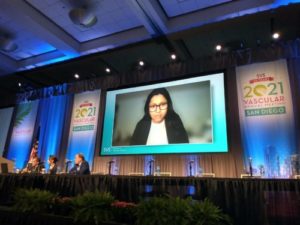
Medical management of type B aortic intramural haematomas is associated with low early mortality but a 19% risk of aortic-related intervention—primarily for proximal descending thoracic aneurysms, researchers from the Mayo Clinic in Rochester, USA, have found.
The investigators report that elevated creatinine, the haematoma thickness and aortic diameter at presentation portend eventual failure of medical management. The findings were delivered during Plenary Session 4 at the Society for Vascular Surgery’s Vascular Annual Meeting (SVS VAM 2021; 18–21 August, San Diego, USA and online) by Parvathi W Balachandran (Mayo Clinic, Rochester, USA).
The study aimed to evaluate the natural history of medically treated aortic intramural haematomas and identify factors linked to faltering medical management.
Balachandran and colleagues gathered data from consecutive patients diagnosed with type B haematomas from 1995 to 2019. A total of 91 were identified. All patients received antihypertensive medications and pain control. Initial management was best medical therapy in 85% (n=77) and surgery in 13% (n=12) of patients. Two patients declined intervention and died within 48 hours, “hence were not included in the study,” said Balachandran.
The primary outcome of the study was 30-day mortality. Secondary outcomes included five-year all-cause and aortic-related mortality, as well as aortic related surgical intervention for dissection or aneurysm.
Balachandran et al found that 30-day mortality was 5% (n=4) among the best medical therapy group and 17% (n=2) in the surgery treatment group. All-cause five-year mortality was comparable between groups (57% vs 50%, p=0.8), with a median survival of 6.8 years after therapy and 5.9 years after surgery. “However, five-year aortic-related mortality was higher in the surgical group at 25% compared to best medical therapy due to high perioperative mortality,” Balachandran said.
Of the 77 patients who were managed with best medical therapy, Balachandran told SVS VAM attendees, 19% (n=15) worsened and eventually required surgery for dissection (n=3) and aneurysm (n=12)—13% had surgery within two weeks of initial diagnosis and 87% required a late surgical intervention. Of the 81% who continued on the best medical therapy track, 2% succumbed to early in-hospital death.
The median freedom from intervention was 4.6 years. On univariate analysis, coronary artery disease, hypertension, baseline creatinine level, peripheral arterial disease, active smoking, intramural haematoma thickness and maximum aortic diameter were independent risk factors for subsequent need for surgery after medical management, the research team discovered. On multivariate analysis, chronic kidney disease with a creatinine >1.2mg/dL, intramural haematoma thickness (>7.7mm) and aortic diameter (>42mm) were predictive risk factors.
Meanwhile, reintervention after initial surgical management was required in 25% (n=3), for aneurysm, endoleak and infected endograft with a median freedom from reintervention of 5.2 (IQR 3–7.9) years.
Balachandran concluded: “Given the nearly five-year time between type B aortic intramural haematoma and need for surgery beyond 30 days, diligent follow-up is needed. These findings provide useful information to guide patient expectations and optimal treatment.”












